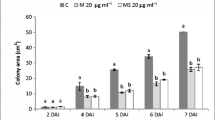Abstract
The antifungal activity and mechanism of fengycin in the presence and absence of commercial surfactin against Rhizopus stolonifer were investigated. The MIC (minimal inhibitory concentration) of fengycin without commercial surfactin added was 0.4 mg/ml while the MIC of fengycin with commercial surfactin added was 2.0 mg/ml. Fengycin acted on cell membrane and cellular organs and inhibited DNA synthesis. The antifungal effect of fengycin was reduced after commercial surfactin was added. All these results suggest that the fungal cell membrane may be the primary target of fengycin action and commercial surfactin may reduce the antifungal activity of fengycin.
Similar content being viewed by others
References
Bechinger, B., M. Zasloff, and S.J. Opella. 1993. Structure and orientation of the antibiotic peptide magainin in membranes by solidstate nuclear magnetic resonance spectroscopy. Protein Sci. 2, 2077–2084.
Bie, X., Z. Lu, and F. Lu. 2009. Identification of fengycin homologues from Bacillus subtilis with ESI-MS/CID. J. Microbiol. Methods 79, 272–278.
Deleu, M., M. Paquot, and T. Nylander. 2008. Effect of fenycin, a lipopeptide produced by Bacillus subtilis, on model biomembranes. Biophys. J. 94, 2667–2679.
Förster, H., G.F. Driever, D.C. Thompson, and J.E. Adaskaveg. 2007. Postharvest decay management for stone fruit crops in California using the “reduced-risk” fungicides fludioxonil and fenhexamid. Plant Dis. 91, 209–215.
Guerra-Sánchez, M.G., J. Vega-Pérez, M.G. Velázquez-del Valle, and A.N. Hernández-Lauzardo. 2008. Antifungal activity and release of compounds on Rhizopus stolonifer (Ehrenb.:Fr.) Vuill. by effect of chitosan with different molecular weights. Pestic. Biochem. Physiol. 93, 18–22.
Hernández-Lauzardo, A.N., S. Bautista-Baños, M.G. Velázquez-del Valle, M.G. Méndez-Montealvo, M.M. Sánchez-Rivera, and L.A. Bello-Pérez. 2008. Antifungal effects of chitosan with different molecular weights on in vitro development of Rhizopus stolonifer (Ehrenb.:Fr.) Vuill. Carbohydr. Polym. 73, 541–547.
Huang, X., Z. Lu, X.B. Bie, F. Lü, H. Zhao, and S. Yang. 2007. Optimization of inactivation of endospores of Bacillus cereus by antimicrobial lipopeptides from Bacillus subtilis fmbj strains using a response surface method. Appl. Microbiol. Biotechnol. 74, 454–461.
Karabulut, O.A. and N. Baykal. 2002. Evaluation of the use of microwave power for the control of postharvest diseases of peaches. Postharvest Biol. Technol. 26, 237–240.
Kim, D.H., D.G. Lee, K.L. Kim, and Y. Lee. 2001. Internalization of tenecin 3 by a fungal cellular process is essential for its fungicidal effect on Candida albicans. Eur. J. Biochem. 268, 4449–4458.
Kluge, B., J. Vater, J. Salnikow, and K. Eckart. 1988. Studies on the biosynthesis of surfactin, a lipopeptide antibiotic from Bacillus subtilis ATCC 21332. FEBS Lett. 231, 107–110.
Maget-Dana, R., L. Thimon, F. Peypoux, and M. Ptak. 1992. Surfactin/iturin A interaction may explain the synergistic effect of surfactin on the biological properties of iturin A. Biochimie. 74, 1047–1051.
Northover, J. and T. Zhou. 2002. Control of rhizopus rot of peaches with postharvest treatments of tebuconazole, fludioxonil, and Pseudomonas syringae. Can. J. Plant Pathol. 24, 144–153.
Singh, P. and S.S. Cameotra. 2004. Potential applications of in biomedical sciences. Trends Biotechnol. 22, 142–146.
Vanittanakom, N., W. Loeffler, U. Koch, and G. Jung. 1986. Fengycin — a novel antifungal lipopeptide antibiotic produced by Bacillus subtilis F-29-3. J. Antibiot. 39, 888–901.
Zhang, H., L. Wang, X. Zheng, and Y. Dong. 2007. Effect of yeast antagonist with heat treatment on postharvest blue mold decay and Rhizopus decay of peaches. Int. J. Food Microbiol. 115, 53–58.
Author information
Authors and Affiliations
Corresponding author
Rights and permissions
About this article
Cite this article
Tao, Y., Bie, Xm., Lv, Fx. et al. Antifungal activity and mechanism of fengycin in the presence and absence of commercial surfactin against Rhizopus stolonifer . J Microbiol. 49, 146–150 (2011). https://doi.org/10.1007/s12275-011-0171-9
Received:
Accepted:
Published:
Issue Date:
DOI: https://doi.org/10.1007/s12275-011-0171-9




